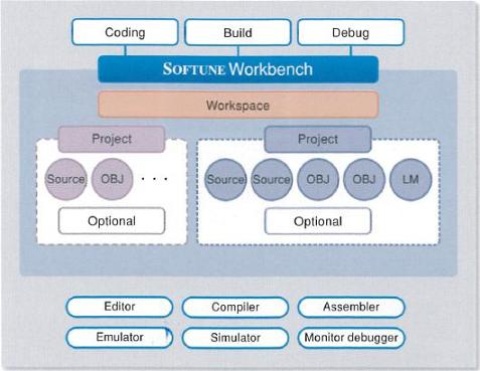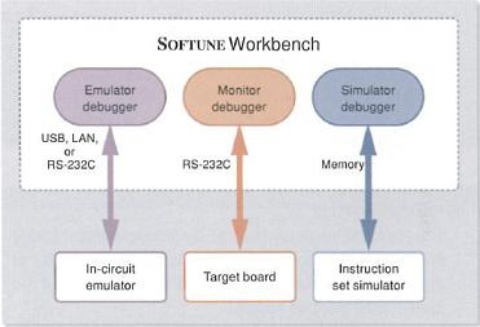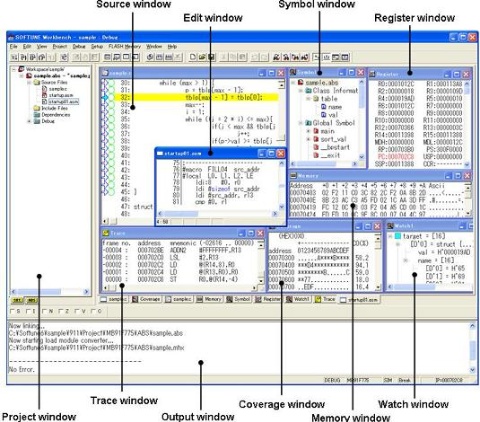Softune Workbench
SOFTUNE Workbench is support software for developing programs for Infineon microcontrollers.
Manager functions
Make function generates a target file by compiling/assembling only updated source files from all source files registered in a project, and then joining all required object files.
Build function generates a target file by compiling/assembling all source files registered with a project, regardless of whether they have been updated or not, and then by joining all required object files.
SOFTUNE Workbench has a built-in include dependencies analysis function. By using this function, uses can know the exact dependencies, even if an include file includes another include file.
SOFTUNE Workbench automatically updates the dependencies of the compiled/assembled files.
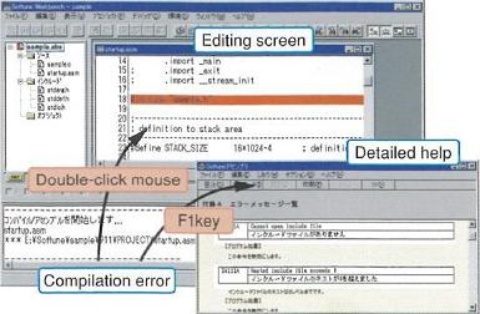
- Editor provided as standard
An editor is built-in as standard, offering a plethora of functions such as keyword highlighting and auto-indenting. - Able to interoperate with third-party editors
In response to the demand for using familiar editors, integration with third-party editors is also possible.
(Mifes V1.0/V3.0, WZ Editor, Tomaru, PowerEditor, Codewright32, TextPAD32, etc.) - Error jump and online help
Errors that occur during a build are displayed in the output window at the bottom of the screen.
Jumping to the tag or displaying error details from the errors shown in this window are easily possible.
The development environment can be customized to suit every individual such as by interoperating with source control tools when sharing files or calling file conversion tools.
- Maintains conventional operability and functions
- GUI for C/C++ compiler option settings
- Built-in editor with colored C/C++ keyword
Debugger functions
- Debugging environment provides a setup wizard
The setup wizard supports settings such as selecting the emulator and board communication lines and the states of windows. The required settings can be made simply by following the on-screen directions. - MCU operating environment
A "CPU information file" that describes device-specific information for all models of supported MCUs is provided as standard. This allows all of the necessary information such as I/O port locations, ROM/RAM capacities, and starting addresses to be configured automatically. - Saving and restoring the debugging environment
The previous debugging environment settings can be saved and the same settings would be restored the next time. (Window layout, breakpoint settings, memory map information, etc.)
- Conform to USB communication for a emulator
- Download of debugging information was made high-speed by the "on-demand loading" technique.
- Speedup of simulation speed
- By simulating the behavior of the cache and pipeline, execution speed can be estimated with high accuracy for FR80 family.
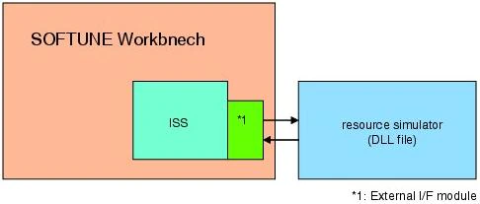
Fast version of simulator debugger supports the external I/F to create peripheral simulation modules.
This microcontroller resource simulator is created by the dynamic link library (DLL) file for Windows.
The interface between the ISS and the microcontroller resource simulator is called in the following timing:
- When the Debugger is started
- When the Debugger is terminated
- When the target is reset
- Immediately before data is read from memory (I/O)
- Immediately after data is written to memory (I/O)
- Immediately before fetching is performed
- When an interrupt occurs
- When a timer event occurs
There are the following functions for operating the ISS from the microcontroller resource simulator:
- Reads/writes data from/to memory
- Reads/writes data from/to registers
- Sets interrupt sources
- Requests abort of instruction execution
- Supports C++ languages
- Refers to member pointers and parent-class member
- Tree-based display of class information in symbolic window
- FLASH loader
The FLASH loader is a program which downloads files to FLASH memory with the target MCU from the SOFTUNE Workbench.
|
- FLASH support
Similar to the RAM area, data can be downloaded to FLASH memory as well as read/written from the memory window.
When data is written into the flash memory, the data is stored temporarily. Subsequently, the contents of the flash memory need to be matched with each other with specific timing.
The matching operation is referred to as "flash memory synchronization" (or, "synchronization of flash memory").
| Features | - Flash memory synchronization [Flash -> Debugger] - Flash memory synchronization [Debugger -> Flash] - Erasing the flash area |
|---|---|
| Use conditions | This function can be used in the following environment. - FR family MB2100-01 emulator - F2MC-8FX family MB2146-08 emulator - F2MC-8FX family MB2146-09 emulator |
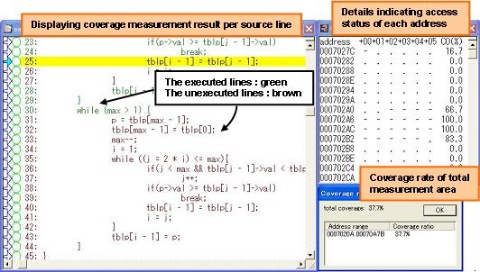
When testing a program, the program is executed with various test data input and the results are checked for correctness. When the test is finished, every part of the entire program should have been executed. If any part has not been executed, there is a possibility that the test is insufficient.
It can know what percentage of the entire program executed when the coverage function for the high-speed version simulator debugger to have is used.
In addition, details such as which addresses were not accessed can be checked.
Displaying coverage measurement result
- Coverage rate of total measurement area
- Displaying coverage rate of load module
- Summary of 16 addresses as one block
- Details indicating access status of each address
- Displaying coverage measurement result per source line
- Displaying coverage measurement result per machine instruction
This function can be used in the following environments:
- FR family SOFTUNE high-speed version simulator debugger
- F2MC-16 family SOFTUNE high-speed version simulator debugger
- F2MC-16 family SOFTUNE emulator debugger (MB2141)
- F2MC-16 family SOFTUNE emulator debugger (MB2147-01)
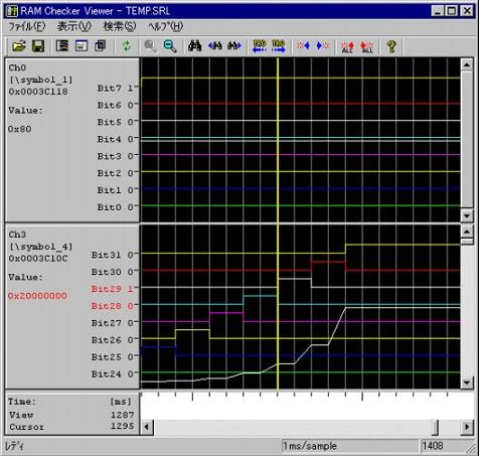
The RAM Checker obtains the access history of the monitoring address log in the SOFTUNE Workbench, and displays the log file graphically using the attached tool "RAM Checker Viewer".
The SOFTUNE Workbench has the following functions:
- Monitoring Point Count: 8 points (FR family), 16 points (F2MC-16 family)
- Event Functions: Max. 4 points (FR family), Max. 8 points(F2MC-16 family)
- Sampling Time: 1 ms (Fixed)
- Update Intervals: 100 ms (Fixed)
The RAM Checker operates under the following conditions:
- FR family SOFTUNE emulator debugger (MB2198)
- CPU: FR60Lite or FR80S
- Adaptor board: Has the external trace function.
- Communication device: USB
- Setting of debug mode: RAM Checker mode
- F2MC-16 family SOFTUNE emulator debugger (MB2147-01)
- Communication device: USB
- Setting of debug mode: RAM Checker mode

